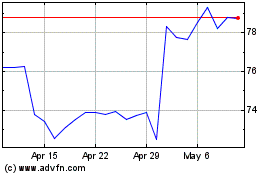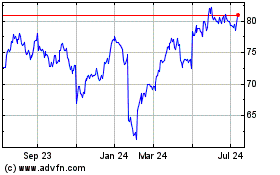By Kris Maher and Cameron McWhirter
A $671 million settlement announced Monday between DuPont Co.
and lawyers representing thousands of people in Ohio and West
Virginia could bring a swift end to years of litigation there,
while fueling cases in other states where people have alleged
health problems after a chemical used to make Teflon got into their
drinking water.
The proposed settlement, which needs to be approved by
individual plaintiffs, comes amid growing concern over the
potential effects of perfluorooctanoic acid, or PFOA, on
drinking-water quality and health. It also comes as a range of
other hazards to the nation's aging drinking-water infrastructure,
from lead pipes to farm runoff to the presence of other industrial
chemicals, gain widespread attention.
In New York, Vermont and elsewhere, state investigations have
found high levels of PFOA in water systems near current and former
manufacturing sites where companies used the chemical for decades
to make everything from Teflon frying pans to Gore-Tex waterproof
jackets to pizza boxes.
The DuPont settlement could provide a boost to other PFOA
lawsuits that have sprung up against other companies in New York
and other states, experts said Monday. But the experts also said
that the facts in those cases, including the actions taken by
companies and alleged health problems, would ultimately determine
their outcome.
"The fact that DuPont was willing to put up real money for
settlement of these claims has to be a shot in the arm for
plaintiffs' lawyers pursuing similar claims elsewhere," said Howard
Erichson, a law professor at Fordham University School of Law.
He cautioned that residents had yet to approve the settlement in
principle between lawyers representing them and DuPont.
Monday's settlement covers roughly 3,500 personal injury
lawsuits against DuPont that grew out of an original lawsuit in
1999. Residents alleged that DuPont was negligent in allowing PFOA
from its plant in Parkersburg, W.Va., to taint drinking water when
the company knew for years about the contamination and potential
health risks from PFOA exposure.
DuPont said it would pay half of the total $670.7 million
settlement, while Chemours Co., which DuPont spun off in 2015,
would pay the other half. Both companies denied any wrongdoing.
Other terms of the settlement weren't released.
The lawsuits include roughly 210 claims involving kidney cancer,
70 claims involving testicular cancer and 1,430 claims involving
thyroid disease, according to a DuPont securities filing.
"We are pleased to have reached a mutually satisfactory
resolution for all parties that brings this matter to a close,"
said Dan Turner, a spokesman for DuPont. David Shelton, general
counsel of Chemours, said the agreement provides "a sound
resolution" for residents, Chemours and the public.
Mike Papantonio, a lawyer representing clients in Ohio and West
Virginia who sued DuPont, said he thought most people will accept
the settlement rather than potentially waiting years for their
cases to reach trial. People with cancer claims could receive
roughly $1.5 million each, he said.
"You can't try these one at a time forever," Mr. Papantonio
said. "I can't see any people really saying this is not something
that we want."
Jury verdicts in recent trials had gone against DuPont, with a
jury in Columbus, Ohio, last month hitting the company with $10.5
million in punitive damages. Last year, in the first PFOA personal
injury cases to be tried against DuPont, the company settled three
for undisclosed sums and lost three at trial with total combined
damages of roughly $20 million.
Patrick McGinley, a law professor at West Virginia University in
Morgantown, W.Va., said those verdicts gave both sides a strong
indication of the total liability. He also said he thought greater
public awareness of drinking water problems could boost
verdicts.
"We are far beyond where the public was 30 years ago, and people
are generally aware that, yes, there can be things in the drinking
water that are very harmful," he said. "The publicity is
extraordinarily negative."
About 40 of the 3,500 PFOA cases against DuPont had been set to
go to trial in Ohio and West Virginia this year.
In a separate case, a federal judge said last month that a PFOA
lawsuit could proceed against Honeywell International, which once
owned a plant in Hoosick Falls, N.Y., that handled PFOA, and
Saint-Gobain Performance Plastics, a subsidiary of Saint-Gobain SA
of France, which owns it now. The companies sought to have it
dismissed.
"Companies like Saint Gobain and Honeywell who we have alleged
have done the same cannot take this settlement lightly and must
realize they may face a similar fate if they try these cases," said
Roopal Luhana, a lawyer representing residents in Hoosick Falls,
N.Y., who said they have been harmed by PFOA.
Saint-Gobain issued a statement Monday evening stating that the
company "never manufactured PFOA at any of its locations" but did
buy material from other companies that in the past used PFOA in
processing. The company initially declined to comment on the
settlement but released a statement later Monday night stating, "We
do not believe the DuPont settlement gives the plaintiffs'
attorneys in our case additional leverage because we will have a
full opportunity to ask the Courts to critically evaluate the
science surrounding PFOA."
A Honeywell spokeswoman said the company is reviewing the court
decision and is committed to working with state officials to
investigate the environmental conditions at the plant and cleaning
them up. She declined to comment on the DuPont settlement.
The DuPont settlement was reached midway through a trial in
Columbus involving Larry Moody, 57, a pipe fitter who said DuPont
enabled PFOA to contaminate water he drank, which in turn caused
his testicular cancer.
A lawyer for Mr. Moody said he approved settlement of his case,
and that the jury was discharged Monday morning.
Patrick Long, a lawyer defending DuPont against Mr. Moody's
claims, told the jury that the company "exercised the highest
degree of care and concern for their employees" and the
community.
But Mr. Moody's lawyers showed a jury dozens of internal DuPont
documents to argue that the company knew of the health risks of
PFOA to residents and how difficult it is for the body to rid
itself of the chemical, a property known as biopersistence.
"Our story is not a good one," a DuPont lawyer wrote in a
November 2000 memo cited in the case. "We continued to increase our
emissions into the river in spite of internal commitments to reduce
or eliminate the release of this chemical into the community and
the environment because of our concern about the biopersistence of
this chemical."
Mr. Turner, the DuPont spokesman, declined to comment on the
memo.
Write to Kris Maher at kris.maher@wsj.com and Cameron McWhirter
at cameron.mcwhirter@wsj.com
(END) Dow Jones Newswires
February 14, 2017 02:47 ET (07:47 GMT)
Copyright (c) 2017 Dow Jones & Company, Inc.
DuPont de Nemours (NYSE:DD)
Historical Stock Chart
From Mar 2024 to Apr 2024

DuPont de Nemours (NYSE:DD)
Historical Stock Chart
From Apr 2023 to Apr 2024
